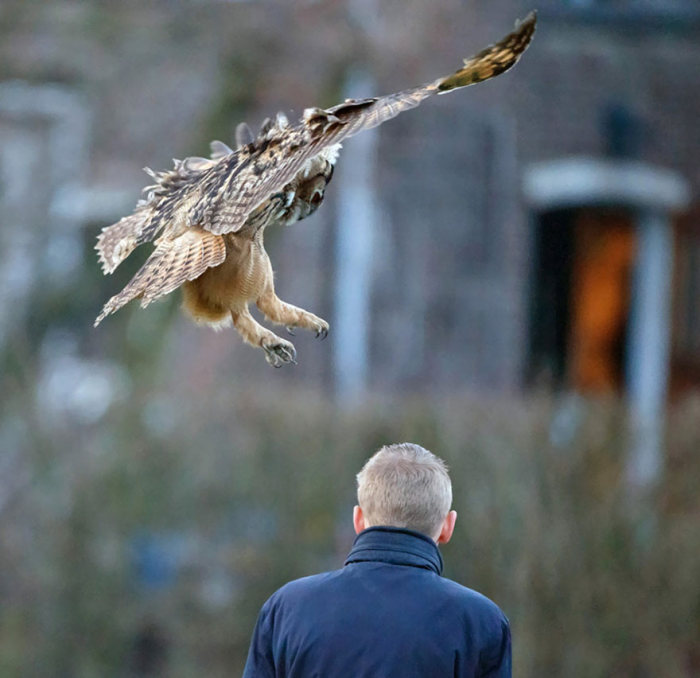|
|
Eurasian Eagle Owl Lands On A Head
|
Great horned owls. Whether these are examples of mimicry either way is unclear but it is known that both Bubo owls are serious predators of long-eared owls. The same discrepancy in underside streaking has also been noted in the Eurasian and American representations of the grey grey owl. A few other related species overlap minimally in range in Asia, mainly in east Asia and the southern reaches of the Eurasian eagle-owl’s range. Three fish owls appear to overlap in range, the brown (B. zeylonensis) in at least northern Pakistan, probably Kashmir and discontinuously in southern Turkey, the tawny (B. flavipes) through much of eastern China and the Blakiston's fish owl in the Russian Far East, northeastern China and Hokkaido. Fish owls are distinctively different looking, possessing more scraggy ear tufts that hang to the side rather than sit erect on top of the head, generally have more uniform, brownish plumages without the contrasting darker streaking of an eagle-owl. The brown fish owl has no feathering on the tarsus or feet and the tawny has feathering only on the upper portion of the tarsi but the Blakiston’s is nearly as extensively feathered on the tarsi and feet as the eagle-owl. Tawny and brown fish owls are both slightly smaller than co-occurring Eurasian eagle-owls and Blakiston’s fish owls are similar or slightly larger than co-occurring large northern eagle-owls. Fish owls, being tied to the edges of freshwater where they hunt mainly fish and crabs, also have slightly differing, and more narrow, habitat preferences.
In the lower Himalayas of northern Pakistan and Jammu and Kashmir, along with the brown fish owl, the Eurasian eagle-owl at the limit of its distribution may co-exist with at least two to three other eagle-owls. One of these, the dusky eagle-owl (B. coromandus) is smaller, with more uniform tan-brownish plumage, untidy uniform light streaking rather than the Eurasian’s dark streaking below and an even less well-defined facial disc. The dusky is usually found in slightly more enclosed woodland areas than Eurasian eagle-owls. Another is possibly the spot-bellied eagle-owl (Bubo nipalensis), which is strikingly differ looking, with stark brown plumage, rather than the warm hues typical of the Eurasian, bold spotting on a whitish background on the belly, and somewhat askew ear tufts that are bold white with light brown crossbars on the front. It is possible that both species occur in some parts of the Himalayan foothills but they are not currently verified to occur in the same area, in part this is because of the spot-bellied’s preference for dense, primary forest. Most similar, with basically the same habitat preferences and the only one verified to co-occur with the Eurasian eagle owls of the race B. b. turcomanus in Kashmir is the Indian eagle-owl (B. bengalensis). The Indian species is smaller with a bolder blackish facial disc border, more rounded and relatively smaller wings and partially unfeathered toes. Far to the west, the pharaoh eagle-owl (B. ascalaphus) also seemingly overlaps in range with the Eurasian, in at least the country of Jordan. Although also relatively similar to the Eurasian eagle-owl, the pharaoh is distinguished by its smaller size, paler, more washed-out plumage and the notably diminished size of its ear-tufts.
|
|









